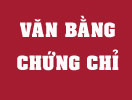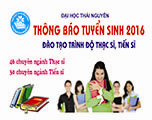Thông tin luận án
Ngày 08-06-2021
Trang thông tin luận án của Nghiên cứu sinh Bùi Duy Hưng
THÔNG TIN LUẬN ÁN TIẾN SĨ
Tên đề tài luận án: "Đặc điểm dịch tễ học bệnh tay chân miệng và hiệu quả một số giải pháp can thiệp phòng chống dịch tại tỉnh Thái Nguyên"
Chuyên ngành: Y tế công cộng; Mã số: 9.72.07.01
Họ và tên nghiên cứu sinh: Bùi Duy Hưng
Người hướng dẫn khoa học:
Hướng dẫn 1: PGS.TS Nguyễn Minh Tuấn
Hướng dẫn 2: PGS.TS Hạc Văn Vinh
Đơn vị đào tạo: Trường Đại học Y - Dược, Đại học Thái Nguyên
NHỮNG KẾT QUẢ MỚI CỦA LUẬN ÁN
1. Dịch tễ học bệnh tay chân miệng tại tỉnh Thái Nguyên giai đoạn 2011- 2015:
Tỷ lệ mắc tay chân miệng tại Thái Nguyên giai đoạn 2011-2015 không ổn định, lần lượt từng năm là: 20,7; 56,3; 34,3; 18,8 và 24,9/100.000 dân; Chủ yếu là trẻ em dưới 5 tuổi (trên 90,7%), trẻ trai cao hơn trẻ gái (trẻ trai chiếm trên 55,1%). Thời điểm bùng phát dịch thường vào tháng 8-9 và tháng 4 hàng năm; Chủ yếu là ổ dịch cộng đồng (46,9%), dịch tản phát (35,5%), dịch trường học (7,0%).
2. Đáp ứng phòng chống dịch tay chân miệng của tuyến y tế cơ sở và sự tham gia của cộng đồng tại huyện Đại Từ, tỉnh Thái Nguyên năm 2016:
Đáp ứng phòng chống dịch còn hạn chế: Kỹ năng tốt nhất của CBYT là phát hiện ca bệnh (34,5%), của YTTB là khử khuẩn môi trường (18,9%). Nhân viên y tế: Có kiến thức tốt về phòng chống tay chân miệng chiếm 55,6%, thái độ tốt 64,8%, thực hành tốt 27,8%; Có kỹ năng tư vấn tốt 17,6%, trung bình 57,4% và kém 25%; Nói chuyện sức khỏe tốt 23,1%, trung bình 63,0%, kém 13,9%.
Kiến thức, thái độ, thực hành của giáo viên mầm non về phòng chống tay chân miệng ở mức trung bình: 35% có kiến thức tốt, 22,5% thực hành tốt và 22,5% thái độ tốt. Kiến thức, thái độ, thực hành của bà mẹ hầu là trung bình và kém: Chỉ 15% có kiến thức tốt, 13,8% thực hành tốt và 63% thái độ tốt.
3. Hiệu quả của chương trình can thiệp phòng chống dịch tay chân miệng:
Trạm y tế 2 xã can thiệp đã có người làm nhiệm vụ cách ly ca mắc, sự phối hợp liên ngành đạt mức độ tốt tăng từ 26,7% lên 73,3%. Đáp ứng phòng chống dịch: Của CBYT tại nhóm can thiệp đều được cải thiện trong đó kỹ năng điều tra dịch và khử khuẩn môi trường tăng từ 26,7% lên 73,3%. Hiệu quả can thiệp của nhân viên y tế: về kiến thức, thái độ, thực hành lần lượt 0,1%; 28,5% và 34,4%; về tư vấn, nói chuyện sức khỏe lần lượt 37,8%, và 41,6%. Hiệu quả can thiệp về kiến thức, thái độ, thực hành: của giáo viên mầm non lần lượt là 29,0%, 16,7%, 22,3%; của bà mẹ có con dưới 5 tuổi lần lượt là 29,3%; 22,3% và 18,8%.
CÁC ỨNG DỤNG, KHẢ NĂNG ỨNG DỤNG TRONG THỰC TIỄN,
NHỮNG VẤN ĐỀ CÒN BỎ NGỎ CẦN TIẾP TỤC NGHIÊN CỨU
Nghiên cứu cung cấp những số liệu có giá trị về đặc điểm dịch tễ học bệnh tay chân miệng tại tỉnh Thái Nguyên trong 05 năm (2011- 2015), đồng thời phân tích khả năng đáp ứng phòng chống dịch của tuyến y tế cơ sở. Đây là cơ sở khoa học giúp ngành Y tế chủ động xây dựng kế hoạch phòng chống tay chân miệng ở khu vực miền núi với nguồn lực còn hạn chế.
Phòng chống dịch bệnh tay chân miệng cần có sự tham gia của Chính quền địa phương - Gia đình - Giáo viên mầm non. Trạm y tế xã là đơn vị chuyên môn xây dựng các chương trình cập nhật kiến thức, kỹ năng phòng chống dịch tay chân miệng phù hợp với từng đối tượng để huy động tối đa sự tham gia của cộng đồng và sử dụng các nguồn lực sẵn có của địa phương, đặc biệt là tình huống diễn tập phòng chống dịch nhằm sẵn sàng ứng phó khi có dịch xảy ra. Do đó các địa phương có nguy cơ cao nên diễn tập phòng chống dịch ít nhất 01 lần vào tháng 3 hàng năm, trước mùa dịch xảy ra.
Mô hình can thiệp có thể nhân rộng ở các địa bàn khác trong tỉnh Thái Nguyên nói riêng và các tỉnh miền núi phía Bắc nói chung, nhưng cần đặc biệt quan tâm đến những yếu tố có ảnh hưởng trực tiếp đến sự tham gia của cộng đồng: Trình độ dân trí, phong tục của người dân; Điều kiện địa lý, kinh tế - chính trị - xã hội... Sự quan tâm, giám sát của y tế và lãnh đạo cấp trên.
INFORMATION OF THE DOCTORAL DISSERTATION
Title of the dissertation: “Epidemiological characteristics of hand, foot and mouth disease and the effectiveness of some interventions for the prevention and control of HFMD epidemic in Thai Nguyen province”
Speciality: Public Health; Code: 9.72.07.01
PhD Student: Bui Duy Hung
Supervisors:
Supervisor 1: Assoc. Prof. Dr. Nguyen Minh Tuan
Supervisor 2: Assoc. Prof. Dr. Hac Van Vinh
Educational facility: University of Medicine and Pharmacy, Thai Nguyen University
NEW RESULTS OF THE DISSERTATION
1.Epidemiology of hand, foot and mouth disease in Thai Nguyen province in the 2011-2015 period:
The unstable incidence of hand, foot and mouth disease in Thai Nguyen in the 2011-2015 period was 20.7, 56.3, 34.3,18.8 and 24.9 per 100,000 people for each year respectively; mainly children under 5 years old (over 90.7%), boys accounting higher rate than that of girls (boys account for over 55.1%). The outbreak time was usually in August, September and April yearly; mainly community outbreaks (46.9%), sporadic outbreaks (35.5%), and school epidemics (7.0%).
2. The prevention and control response to HFMD epidemic from the grassroots-level clinics and community participation in Dai Tu district, Thai Nguyen province in 2016
Limitation in response to the epidemic prevention and control: the best skills of HWs and HHWs were to detect cases with HFMD (34.5%), and to disinfect the environment (18.9%) respectively. Health workers: good knowledge, attitude and practice of HWs regarding HFMD prevention and control accounted for 55.6%, 64.8%, 27.8% respectively; their consulting skills accounted for 17.6% at good level, 57.4% at average level and 25% at poor level; their health speaking skills accounted for 23.1% at good level, 63.0% at average level, and 13.9% at poor level.
Knowledge, attitude and practice of preschool teachers on the prevention and control of hand, foot and mouth disease were average: good knowledge, practice and attitude accounted for 35% , 22.5% and 22.5% respectively. The knowledge, attitude and practice of mothers were average and poor: Only 15% had good knowledge, 13.8% had good practice and 63% had good attitude.
3. Theeffectivenessof intervention program for the prevention and control of HFMD epidemics
In the two commune health stations intervened , there were people in charge of isolating cases with HFMD and inter-sectoral coordination reached a good level, and increased from 26.7% to 73.3%. HWs' response to the epidemic prevention and control in the intervention group was improved, in which the skills of epidemic investigation and environmental disinfection increased from 26.7% to 73.3%.
Intervention effectiveness of health workers: Their knowledge, attitude, and practice accounted for 0.1%; 28.5% and 34.4% respectively; their counseling and health speaking accounted for 37.8%, and 41.6% respectively. The effectiveness of intervention on knowledge, attitude and practice: of preschool teachers accounting for 29.0%, 16.7%, and 22.3% respectively; of mothers with children under 5 years old accounting for 29.3%; 22.3% and 18.8% respectively.
APPLICATIONS, PRACTICAL APPLICABILITY,
FURTHER RESEARCH FOR OPENED ISSUES
The research project provided valuable data on the epidemiological characteristics of hand, foot and mouth disease in Thai Nguyen province in 5 years (2011-2015), and analyzed the response capacity of grassroots-level clinics to epidemic prevention and control. This is a scientific basis to help the health sector proactively develops the prevention and control plan of hand, foot and mouth disease in mountainous areas with limited resources.
Prevention and control of HFMD epidemics requires the participation of local authorities, families and preschool teachers. The commune health station is a specialized medical unit in building programs to update suitable knowledge and skills on the prevention and control of HFMD epidemics for each subject to to mobilize maximum of community participation and use of resources of local availability, especially in the situation of epidemic prevention and control drills to be ready to respond when an epidemic occurs. Therefore, high-risk localities should have epidemic prevention and control rehearsal at least once in March every year, before the epidemic season occurs.
The intervention model can be replicated in other areas in Thai Nguyen province in particular and the Northern mountainous provinces in general. However, factors that have a direct impact on community participation such as the people's intellectual level, the people’s customs, the geographical, economic, political and social conditions, etc. should pay special attention to; It should have attention and supervision of health sector and senior leaders.
Nguồn: Trường Đại học Y - Dược, Đại học Thái Nguyên.

















